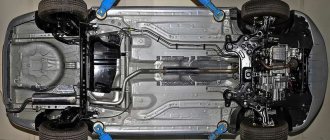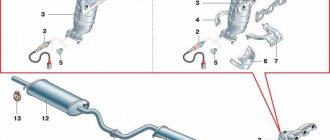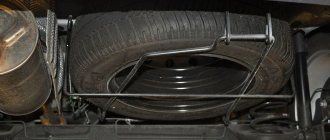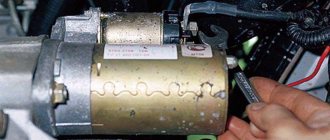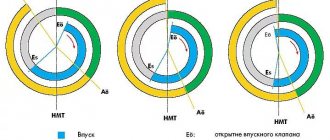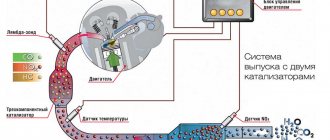20.05.2019
| (Votes: 8, Rating: 4.75) |
Issues discussed in the material:
- Why does thick white smoke come from the exhaust pipe of a gasoline engine?
- What can cause white smoke to come out of a diesel exhaust pipe?
- How to determine the cause of white smoke from the exhaust pipe of a gasoline engine
- How to Diagnose the Cause of White Smoke from a Diesel Exhaust Pipe
Usually in winter, most car owners do not pay attention to the fact that white smoke comes from the exhaust pipe. However, in the warm season, this looks at least strange, regardless of whether the car has a diesel or gasoline engine. The article talks about what the causes of strong white exhaust can be and how serious they are.
Why is there thick white smoke coming from the exhaust pipe: possible reasons
Do not immediately think that this is a sign of serious problems with the engine. Most often, smoke appears due to water vapor formed in the exhaust system. This usually happens during the cold season, when the outside temperature is no higher than plus five degrees. Then, when you start a cold engine, steam comes out. This phenomenon is also typical for wet weather, if it is rainy, cloudy or foggy outside. While the engine is running, the exhaust system warms up and the smoke stops coming out.
However, if strong white smoke comes out of the exhaust pipe when the engine is warm, this may indicate a malfunction. Here's how it shows up:
- White smoke comes out the moment you start the engine and does not stop even as it warms up.
- White puffs fly out if you press the pedal hard, but when the engine is idling, nothing like this is observed.
Experienced car owners can easily navigate such faults, accurately determine the cause and know how to eliminate it. But it’s more difficult for a novice driver, because in wet weather intense white smoke from the exhaust pipe is a common occurrence, and here you need to understand its intensity and duration. This can happen for various reasons.
- Clogged filters.
This may seem strange to some, but it is precisely because of dirty engine filters that the system can produce copious emissions, often even black. This happens because less air is supplied and more fuel is supplied.
- Technical malfunction.
Strong white smoke from the exhaust pipe in the warm season, even when the engine is idling, is a sure sign of a malfunction.
- Refrigerant leak.
Refrigerant may enter the manifold. How to recognize that this has happened? It will be seen that the coolant is consumed much faster, and the engine speed has become uneven. The important elements of an internal combustion engine are the head with the camshaft and the cylinder block. These structural components are separated by a gasket. In general, the entire system must be sealed so that there is no leakage of antifreeze, which provides protection against overheating. The problem may arise if the cylinder head is installed incorrectly, there are slight deflections, or the valve is burnt out.
- Wear of certain elements.
In the engine, the motor piston is equipped with a ring that limits the entry of lubricants into the fuel mixture. During operation, continuous friction occurs, in addition, there is a combustion chamber nearby, so parts wear out, become hard, or completely fail. As a result, the gaps increase and oil can get into the fuel.
We recommend
“How they deceive you at a car service center and what you can do to protect yourself” Read more
Why does a gasoline engine smoke black?
If the engine consistently emits black smoke, this indicates increased air consumption. The shade can be different: black, gray or dark gray. It occurs due to excessive soot content, which appears due to a violation of the combustion efficiency of gasoline. Checking the supply system will help eliminate smoke.
The malfunction has an indirect and sometimes direct relationship to the following symptoms:
- the engine has to be turned longer to start;
- fuel consumption increases every time;
- power drops;
- The catalyst gets very hot and then becomes clogged with soot, which is why it has to be replaced.
Design features of the power plant
All cars are very different, and there are many that differ in some design features. For example, Swedish SAABs, produced in the nineties, are equipped with a special valve with a vacuum hose. And if transmission oil ends up in the engine through it, then white smoke appears from the exhaust pipe.
This is not critical for the engine, but it will perform worse. Lubricants necessary for the normal operation of the structural elements of the gearbox eventually clog the glow plugs. This in turn suppresses the spark and, naturally, affects the efficiency of the engine.
What to do if you detect dense white smoke
When disassembling the cylinders, it is necessary to analyze the condition of the spark plugs. The formation of scale on the candles indicates that water has gotten inside. After examining all cylinders and glow plugs located in them, it is necessary to repair or replace the cylinders and glow plugs. It is recommended that these measures be carried out with the help of qualified technicians at the nearest service station.
Often, low-quality coolants, when in contact with the working elements of the engine, cause increased corrosion of components and parts of the power unit. Cheap varieties of antifreeze can literally corrode the internal parts of the engine when leaks occur. After such an impact, it is not possible to repair damaged parts.
To ensure that the coolant penetrates into the combustion chamber, it is necessary to remove the cap from the expansion tank. A sharp burning smell, a decrease in the level of antifreeze in the tank, and a floating oil film indicate the detection of this defect.
Reasons for the appearance of white smoke from the exhaust pipe of a diesel engine
There are several defects that cause white exhaust:
- At the time of starting and warming up the engine, there was a lot of humidity in the muffler.
- Unburnt fuel remains in the diesel engine.
- Antifreeze penetrates into the combustion chamber.
As for the appearance of white exhaust due to moisture collected in the muffler, this is a normal phenomenon. When the engine starts, a little accumulated moisture simply flows out, and what does not flow out rapidly evaporates during the warming up process and gives the exhaust a white color. The smoke stops coming out after the system has warmed up sufficiently and the condensate has completely evaporated.
The second of these reasons is incomplete combustion of fuel, delay in its ignition. Moreover, this happens not only in case of malfunctions in a diesel engine, but also in a normal working engine in the cold season.
If the diesel engine is working properly, but the fuel still does not ignite at the right time, it may be because the cylinder walls are not warmed up enough. White smoke is not considered a problem and will disappear after the engine warms up normally.
However, the appearance of white smoke from the exhaust pipe on a warm engine may indicate that:
- The plunger pairs in the fuel pump have become unusable.
- There is a problem with the spark plugs.
- There is insufficient pressure in the cylinders.
- The injection into the injectors occurs under too much pressure.
What do such problems lead to? In the engine, the angle of fuel injection changes, the moment of its ignition in the cylinders is delayed, so the engine can be difficult to start, not only when it has cooled down, but also when it is well warmed up. In this case, twitching may be observed when the diesel engine is idling, or it may stall if a load is applied.
In addition, there is a noticeable decrease in engine power: acceleration is more difficult and takes longer, more fuel is wasted, and the engine responds with a delay to pressing the gas pedal.
The third reason why white smoke pours out of the exhaust pipe is the most serious and poses the greatest danger specifically for diesel engines. Antifreeze that gets into the engine cylinders causes the formation of sulfur oxide, which significantly shortens its service life.
Most often, coolant ends up in the engine because:
- The sealing gasket in the cylinder head is worn or damaged.
- The cylinder head or the block itself is cracked (happens less frequently).
It happens that the intake manifold gasket is damaged, then antifreeze ends up in the combustion chamber through the fuel intake system.
It is important to pay attention to the problem in a timely manner, otherwise it may cause water hammer, the connecting rods will fail, or there may even be a need for a major overhaul of the engine.
We recommend
“Stages of engine diagnostics: what determines the sequence of work” Read more
The engine emits blue smoke
The engine begins to smoke blue or gray smoke if an excess amount of engine oil penetrates the cylinders. This smoke may be blue, blue, or similar shades. Engine oil smoke is thicker. If you bring paper to the exhaust pipe, greasy stains will remain on it.
The first sign that will indicate the cause of smoking is a significant excess consumption of oil (from 0.5 liters of oil per 1 thousand kilometers). In some cases, it is difficult to identify the problem only by the color of the exhaust. Diagnosis is complicated by the presence of a catalyst that purifies exhaust gases.
Definition of failure
Oil penetrates into the combustion chamber both through the piston rings and through the leaks between the valve stem and its guide sleeve. In the first case, wear of the CPG occurs. The list of possible problems includes:
- Compression and oil scraper rings are worn out;
- development of ring grooves in the piston itself;
- change in the shape of the cylinder walls, wear of the walls;
- the presence of scoring on the cylinder walls;
The wear of the CPG elements often coincides with the fact that the compression in the engine decreases. An increase in crankcase gas pressure is also possible. It should be added that in case of slight wear of parts, the engine will smoke blue smoke only when “cold”. As the engine heats up and the thermal expansion of the parts, the gaps between the parts in the cylinder can return to relative normal. As a result, the engine smokes less noticeably or the smoke disappears completely. If the wear of the CPG is significant, then as the engine warms up, it will begin to smoke more, since the heated oil dilutes and enters the combustion chamber more actively. Thermal expansion of parts with severe wear can no longer compensate for the increased gaps.
On cars with a turbocharger, blue smoke can separately indicate problems with the turbine. Most often, a turbocharged engine smokes because the turbine rotor bearings and seals are worn out. In such cases, the oil enters the exhaust system through the turbocharger and burns out, forming oil smoke.
As for the timing belt, oil smoke is often associated with wear on the valve stem, guide bushings and problems with valve stem seals. The engine may also smoke blue exhaust if there are ignition problems. To check, you can unscrew the spark plug on the problem cylinder. The presence of abundant black carbon deposits will indicate a problem.
A fairly rare cause of blue exhaust smoke can be a rupture of the special regulator membrane on automatic transmissions that have a vacuum load sensor. A design feature is the connection of such a box with the intake manifold using a special pipe. In the event of a malfunction, the engine simply draws liquid transmission oil from the automatic transmission.
How to determine why white smoke is coming from the exhaust pipe of a gasoline engine
First, carry out a simple inspection: pull out the oil dipstick and check not only the volume of oil, but also what it looks like, has a whitish color appeared, has an emulsion formed? Water getting into the oil often damages the engine.
A characteristic manifestation of such a problem is not white, but even bluish smoke. It leaves a whole foggy cloud behind the car.
Look into the expansion tank. If you smell exhaust fumes and there is a barely noticeable oil film on the antifreeze, these are bad signs.
Another way to tell if water has entered the cylinder is to look at the carbon deposits on the spark plug. In this case, it will be completely clean, as if it had just come from the store, or even wet.
You can understand why white smoke is pouring out of the exhaust pipe using a simple white napkin, which you need to bring to the muffler with the engine running. The napkin will not become dirty if the cause of the smoke is ordinary condensation. Otherwise, noticeable oil marks will appear on it. Leaking antifreeze will leave a sour odor and yellowish or bluish prints. If any of these signs appear, you should climb into the engine and find the cause of the problem.
The gasket may be damaged, the block head or the block itself may be cracked. By the way, when the gasket is broken, the engine suffers.
To detect visible defects, all surfaces should be examined very carefully: the block itself, the block head, the surface from the inside, the intake and exhaust valves and the surrounding areas. It is not always possible to visually notice a crack; pressure testing is often necessary. With large defects, fluid accumulates above the piston. In this case, do not put off car repairs until later, otherwise a water hammer may occur.
For example, an inspection showed that the pressure in the radiator is normal and there is no smell of exhaust gases, but white smoke still comes out, the emulsification process has begun in the oil, and the liquid is consumed too quickly. These are all sure signs that the intake system is leaking fluid. Then you don’t have to remove the head, but just carefully examine the collector.
In general, the root cause of thick, light-colored exhaust is a malfunction of the cooling device, which in turn leads to overheating of the engine. Therefore, it is this problem that needs to be solved; it will not be enough to simply eliminate minor defects that cause white smoke to appear.
Shades of exhaust from cars with carburetor engines
Exhaust smoke from car models with carburetor engines can also have a white, black or bluish tint. They indicate the following malfunctions:
White smoke
White exhaust indicates that water has entered the Niva’s fuel mixture. This can occur as a result of condensation forming in the gas tank or fuel supply pipes, increased humidity during refueling of the vehicle, or water penetration from a damaged engine cooling system.
In addition, white exhaust occurs due to a violation of the tightness of the gaskets, refrigerant entering the engine cylinders, or water leakage in the heating system. In certain situations, white smoke is produced due to insufficient engine warm-up. When its temperature does not reach the required values, a certain amount of water remains in the exhaust system. For this reason, it is not advisable to make short trips in frosty weather.
Exhaust smoke has a bluish hue
Such exhaust can be formed due to oil entering the combustion chamber. This usually occurs due to significant wear of the cylinders and piston system. The degree of wear of the parts of these mechanisms can be determined by measuring the compression level. If this indicator corresponds to the established standard, then the cause of the bluish smoke may be damage to the seals, bushings and valve seals of the Niva.
Possible malfunctions that can cause the formation of bluish smoke also include a reduced degree of elasticity of rings, cuffs, bushings and valve plates, worn valve seats, and an increased oil level. Such smoke also appears due to the use of low-quality fuel with oil impurities.
Black exhaust
Black exhaust has a color that is given to it by soot, which is formed due to incomplete combustion of the fuel mixture.
This happens due to the supply of fuel that exceeds the norm of enrichment to the carburetor. Black exhaust also occurs when there is more fuel in the float chamber than normal. We can also identify such malfunctions as clogged holes, wear and damage to jets, a damaged air supply system damper, a faulty idle air valve, and low-quality spark plugs.
When determining the cause of the formation of Niva exhausts of a certain color and shade, you should remember that such exhausts can be caused by more than just one malfunction. This phenomenon can be a sign of several different damages and breakdowns at once, especially in old cars with worn out parts and mechanisms. However, in general, the above reasons for emissions will allow you to choose the right direction for troubleshooting and repair the Chevrolet Niva or another car in a timely manner.
In the video we'll see how to blow out the exhaust pipe to get rid of black exhaust once and for all.
| 165 posts on previous pages |
The influence of the quality of the oil used on smoke formation
Motor oil must have certain characteristics. The quality of the lubricant used directly depends on its properties. If the car engine contains low-quality oil, the viscosity coefficient of which does not correspond to the car brand, or if the temperature inside the engine increases, a sharp loss of useful properties of the lubricant occurs, this leads to serious damage to the elements and systems of the power unit. If blue smoke appears, you need to check the oil for compliance and, if necessary, completely replace it.
The appearance of smoke can be caused by a number of other reasons - from the appearance of microcracks in the engine body to the use of the wrong type of fuel intended for a given engine brand. Each specific situation always has a solution when seeking help from qualified specialists.
Read news about the new Niva
- Niva winches in St. Petersburg: 500 products: free shipping, 28% discount [go]
- What are the different diesel engine power systems?
- Tightening torques for threaded connections. VAZ 21213, 21214 (Niva)
- Sava - European quality tires
- Front suspension device for VAZ-21213 Lada Niva, VAZ-21214 Niva
- Niva Chevrolet alarm connection points
- Chevrolet Niva 2019-2020: characteristics, price, photo and video review
- How to sell an expensive Niva
Also interesting: Whistling when the engine is running @ Niva 4×4
Other defects
It is worth noting that excess heat not removed from the heart of the car is the main cause of thick clouds of smoke. This is usually caused by the following technical malfunctions:
• The thermostat valve is stuck or completely damaged.
• The cooling radiator is clogged with various types of dirt on the inside or outside.
• The throttle located in the expansion tank plug has ceased to function fully.
• There was a malfunction in the ignition system, it became too late.
• Various types of damage have appeared in the cylinder head, for example, cracks or chips.
Regardless of the true reason for the constant overheating of the power unit, operating such a car is extremely undesirable until the problems are completely eliminated. Otherwise, there is a high probability of your vehicle being idle and a not-so-budgetary visit to the service center.
As for a working internal combustion engine, there is a lot of white smoke coming out of the exhaust pipe if:
• The weather outside is rainy or the air humidity is significantly higher than the established norm.
• Starting a cold engine is carried out at a temperature of 10 degrees below zero.
• Outside the window it is minus 25 or more, and it does not matter whether the power unit is warmed up to its operating temperature or not.
